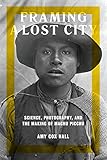Framing a Lost City : Science, Photography, and the Making of Machu Picchu / Amy Cox Hall.
Material type: TextPublisher: Austin : University of Texas Press, [2021]Copyright date: ©2017Description: 1 online resource (267 p.)Content type:
TextPublisher: Austin : University of Texas Press, [2021]Copyright date: ©2017Description: 1 online resource (267 p.)Content type: - 9781477313695
- Anthropological ethics
- Machu Picchu Site (Peru)
- Peru-Antiquities
- Peruvian Expeditions-(1912-1915)
- Photography -- Moral and ethical aspects -- Peru -- Machu Picchu Site
- Photography-Moral and ethical aspects-Peru-Machu Picchu Site
- Yale Peruvian Expedition-(1911)
- Yale Peruvian Expedition-(1912)
- HISTORY / General
- 985/.37 23
- F3429.1.M3 H35 2017
- F3429.1.M3 H35 2017
- online - DeGruyter
| Item type | Current library | Call number | URL | Status | Notes | Barcode | |
|---|---|---|---|---|---|---|---|
 eBook
eBook
|
Biblioteca "Angelicum" Pont. Univ. S.Tommaso d'Aquino Nuvola online | online - DeGruyter (Browse shelf(Opens below)) | Online access | Not for loan (Accesso limitato) | Accesso per gli utenti autorizzati / Access for authorized users | (dgr)9781477313695 |
Frontmatter -- Contents -- List of Illustrations -- Acknowledgments -- A Note on the Text -- Introduction: Seeing Science -- Sight -- 1. Epistolary Science -- 2. Huaquero Vision -- Circulation -- 3. Latin America as Laboratory -- 4. Discovery Aesthetics -- 5. Picturing the Miserable Indian for Science -- Contests -- 6. The Politics of Seeing -- Conclusion: Artifact -- Notes -- Reference List -- Index
restricted access online access with authorization star
http://purl.org/coar/access_right/c_16ec
When Hiram Bingham, a historian from Yale University, first saw Machu Picchu in 1911, it was a ruin obscured by overgrowth whose terraces were farmed a by few families. A century later, Machu Picchu is a UNESCO world heritage site visited by more than a million tourists annually. This remarkable transformation began with the photographs that accompanied Bingham’s article published in National Geographic magazine, which depicted Machu Picchu as a lost city discovered. Focusing on the practices, technologies, and materializations of Bingham’s three expeditions to Peru (1911, 1912, 1914–1915), this book makes a convincing case that visualization, particularly through the camera, played a decisive role in positioning Machu Picchu as both a scientific discovery and a Peruvian heritage site. Amy Cox Hall argues that while Bingham’s expeditions relied on the labor, knowledge, and support of Peruvian elites, intellectuals, and peasants, the practice of scientific witnessing, and photography specifically, converted Machu Picchu into a cultural artifact fashioned from a distinct way of seeing. Drawing on science and technology studies, she situates letter writing, artifact collecting, and photography as important expeditionary practices that helped shape the way we understand Machu Picchu today. Cox Hall also demonstrates that the photographic evidence was unstable, and, as images circulated worldwide, the “lost city” took on different meanings, especially in Peru, which came to view the site as one of national patrimony in need of protection from expeditions such as Bingham’s.
Mode of access: Internet via World Wide Web.
In English.
Description based on online resource; title from PDF title page (publisher's Web site, viewed 26. Apr 2022)


